Most of you will know the constellation of Orion. Here is an image taken by the Hubble Space Telescope. The bright reddish star, forming the left shoulder of the Hunter, is called Betelgeuse. Recently this star has been in the news, because there were indications that it might explode in the (near) future.
With the present level of light pollution, it is often difficult to observe the colors of stars, and you will see only the brightest. Of course a star closer to the Sun will look brighter than a star many hundreds of lightyears away. Taking the distance into account, astronomers can determine the intrinsic brightness of a star, called the luminosity. When you plot the luminosity of stars against their color, you get the diagram below. It’s called the Hertzsprung–Russell diagram, named after the two astronomers who created it around 1910.
As you see, the diagram has a lot of structure and it has helped astronomers a lot to understand how stars evolve. The vertical axis gives the luminosity, in units of the Solar luminosity, while the horizontal axis gives the surface temperature of the star, which is directly related to its color. Notice that the temperature decreases from left to right.
The position of some well-known stars is indicated. Of course our Sun, a yellowish star. Betelgeuse can be found in the upper right corner. it has a luminosity of ~ 100.000 times the Sun ! It is a so-called Red Supergiant Star. A giant star, it’s size is about 900 times the size of the Sun. If it would replace the Sun, we would be swallowed, it would extend to the orbit of Jupiter. The reddish color means that its surface temperature is about 3000K
There are also Blue Supergiant Stars. An example is Rigel, also in Orion (his right leg) with a surface temperature of 11000 K. And there exist White Dwarf Stars, with a size 0.1-0.01 times the Sun, and Giant Stars.
Along the diagonal in the HR diagram you will find the Main Sequence Stars. Most stars are located in this band. Here is a plot of 23000 individual stars in the HR diagram
To understand what will happen in the (near) future to Betelgeuse, I must explain a bit about how stars are formed and how they evolve. Stars are born when clouds of interstellar matter (mainly hydrogen and helium) contract as a result of their own gravity. This contraction increases the temperature in the interior of the cloud until the core becomes so hot ( about 15 million Kelvin) that fusion of hydrogen becomes possible. The energy and radiation from this fusion stops the gravitational contraction, a star is born! Here is a very simplified picture of the fusion process.

Let’s look at the star nearest to us, our Sun, It was born about 4.6 billion years ago, and its total lifetime is estimated to be around 10 billion year, so at the moment it is about halfway its life. Here is a sketch, the fusion takes place in the core, the radiation is transported to the surface (photosphere), resulting for the Sun in a surface temperature of about 5800 K and an orange color.
For a heavier star than the Sun, the inward pressure due to its gravity is stronger, so the counter pressure of the fusion in the core must also be stronger to create a balance. Here are some of the effects:
- The star is bigger and brighter
- Its core temperature is higher, the “burning” of hydrogen faster
- The surface temperature is higher, the color more blueish/whitish
- The lifetime of the star will be shorter
Here is an example: Sirius, the brightest star in the sky. Its mass is two times the mass of the Sun. Compared to the Sun, its radius is 1.7 times larger, its luminosity 25 times larger, its surface temperature is almost 10.000 Kelvin and its lifetime is only about 240 million years. Heavier stars will live even shorter.
We can now explain the Main Sequence in the HR diagram. It is the location of all “normal” stars, who are burning hydrogen in their core. At the lower right we find the low-mass stars, sometimes called red dwarfs , who burn their hydrogen so slowly that their lifetime is many hundred billions of years, longer than the current age of the Universe! At the top left, high-mass stars burn their hydrogen so fast, that in spite of their large mass they have lifetimes of only a few million(!) years.
What happens after the hydrogen fuel in the stellar core is exhausted? That depends on the mass of the star. We will concentrate in this post on the high mass stars (more than 8-10 solar masses), because Betelgeuse is one of them.
In these massive stars, after all hydrogen in the core has been fused into helium, gravitation will contract the core further, raising its temperature, until helium starts fusing into carbon. At the same time the outer layers of the star expand dramatically, while cooling. The star enters its (red) supergiant phase.
The triple-alpha process, as it is called, generates less energy than the hydrogen fusion. Three helium nuclei fuse into on carbon nucleus. Another simplified image.
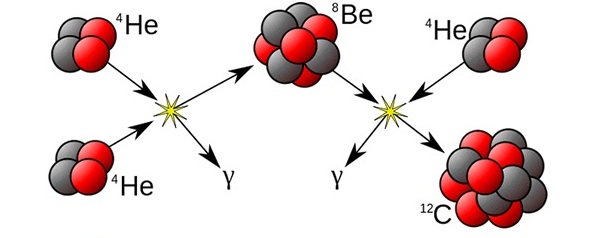
When the core has fused into carbon, the process repeats. Gravitation contracts the core, its temperature increases , and another fusion process starts, leading to a neon core. Next an oxygen core, a silicon core and finally an iron core. Here is a sketch. A few comments. Notice the difference in scale. The outer layers of the red giant extend to the orbit of Jupiter, whereas the core has about the size of Earth! As you see, the central core is surrounded by layers of lower temperature where still fusion of hydrogen helium, etcetera is going on. It’s like the layers of an onion.
The red supergiant phase doesn’t last long, astronomically speaking, the energy of these fusion processes is much less than the hydrogen fusion. Here is an estimate of the time spent in each of the phases for a star of 25 solar masses. Notice the columns for temperature and density.
When the core has become iron , no more energy can be obtained from fusion and the end of the star is near. Gravity will finally win, the core implodes into a neutron star or a black hole while the outer layers are blown away in a cataclysmic explosion. It is called a (Type II) supernova. During a couple of weeks, the supernova may outshine the galaxy it belongs to and release more energy than the Sun during its whole lifetime. If the supernova is not too far away from us, it may become the brightest star in the sky, even visible during daylight. It looks like a new star (nova = new in Latin), but actually we are watching the last throes of a dying star.
Supernovas are extremely rare, they occur about once every 50 years in a galaxy the size of the Milky Way. A few have been recorded in human history, nowadays many more have been observed in other galaxies. In 1054, Chinese astronomers observed a new star, so bright that during a few weeks it was visible during daylight. Their accurate description made it possible for modern astronomers to conclude that it was a supernova (SN1054) and to identify the Crab Nebula as the remnant of this supernova. Here is the Crab Nebula. At its center a neutron star has been found, the Crab Pulsar.
Click here for a list of supernovae that are of historical significance. The most recent one in our own Milky Way galaxy was Kepler’s Star, observed in 1604, more than 400 years ago!
Time to go back to Betelgeuse. As mentioned in the beginning of this post, it is a red supergiant star at a distance of about 640 lightyear from us. Its mass is about 12 solar masses and its estimated lifetime about 8 million year. It has fused all the hydrogen in its core and is now burning helium in its core. Here is a computer animation of how Betelgeuse might look like.
The gigantic (convection) bubbles are characteristics for this kind of stars. Our Sun has them too, but on a much smaller scale.
Betelgeuse is a variable star, it changes its brightness in a rather irregular way. Here is a graph showing the brightness of Betelgeuse between 1990 and now..
From the right part of this graph you may understand why first astronomers and later the media and the general public became so excited about Betelgeuse. Starting October 2019, the star began to fade more than usual, and by the end of January 2020 it had dropped almost a factor 3 in brightness. A very noticeable difference, here are two photos.
Could it be that this dimming was a signal that Betelgeuse was on its way to become a supernova? It would be a spectacular event, the star might become as bright as the moon and be visible in daylight for many weeks. A harmless event too, the distance of 640 lightyear is too far away. By the way, light from Betelgeuse takes 640 year to reach us, so it could have been exploded already, without us knowing it yet 😉 .
Here is an example of a newspaper headline, in this case the Daily Mail , 23 December last year.
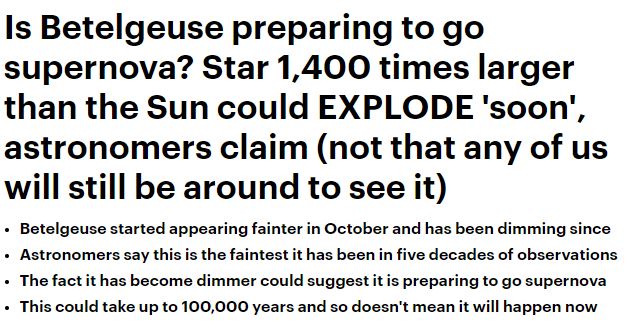
Not surprisingly observers from all over the world have been looking at Betelgeuse the last few months, as you can see in the graph below, notice the density of observations in the last three months :-).
I am sure it must have been a disappointment for many that the last month, the fading stopped and Betelgeuse started to become brighter again.
The last few weeks scientific papers are appearing with possible explanations for the unusual dimming. Probably it has been caused by dust. Supergiant stars regularly spew out some of their material into space, where it may condense into grainy particles, temporarily blocking the light of the star.
So, no supernova? Well, on the long term, it will. Betelgeuse is dying and will go supernova. That can happen in our lifetime, but it can also take 100.000 years or even more (see the table above with lifetimes of the various fusing phase).
I will end this post with two short paragraphs about related topics.
- This blog is about massive stars. Our Sun, a dwarf star, has not enough mass to become a supernova. After exhausting the hydrogen in its core (in about 5-6 billion year) , it will start fusing helium into carbon and oxygen and become a red giant star, swallowing the inner planets, Earth included. But there the fusion stops. Gravity takes over, and the Sun will end as a white dwarf.
- In massive stars, fusion ends when the core has become iron & nickel, because further fusion would need energy instead of releasing it. However, during the supernova explosion so much energy is released that elements heavier than iron can be created. Our Sun is a second-generation star, it was formed from an interstellar cloud that contained, besides hydrogen and helium, already material from earlier supernovae. Earth and everything in it, consists of atoms that have been formed in the interior of stars. We are Star Children, each atom in our body (except hydrogen), has been created inside a star!

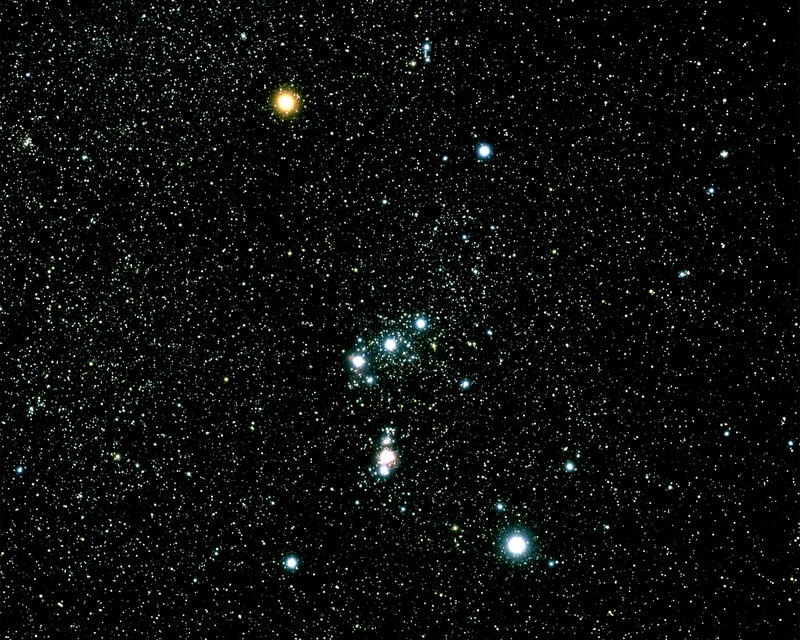
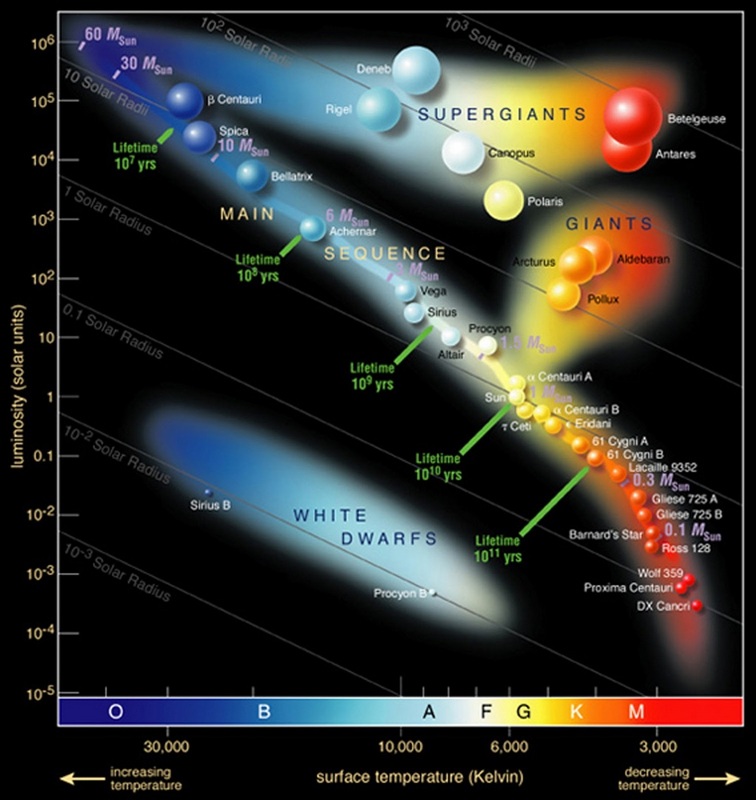
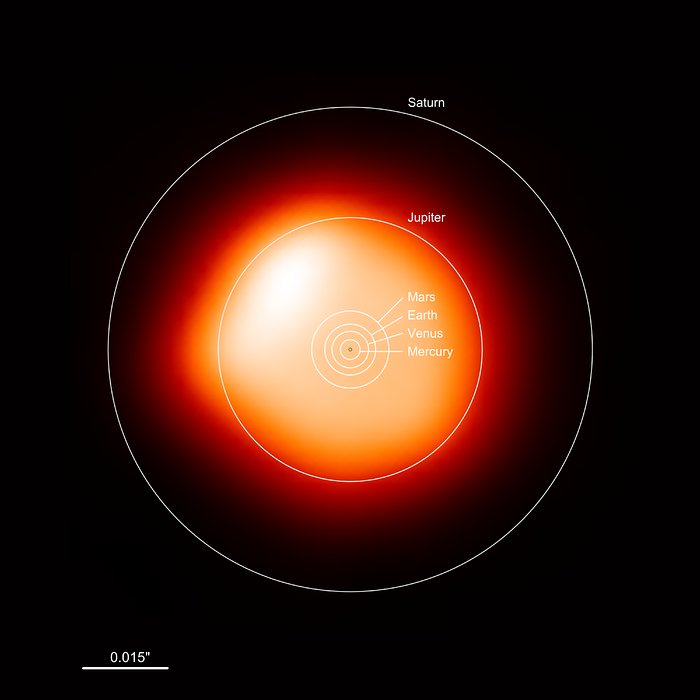
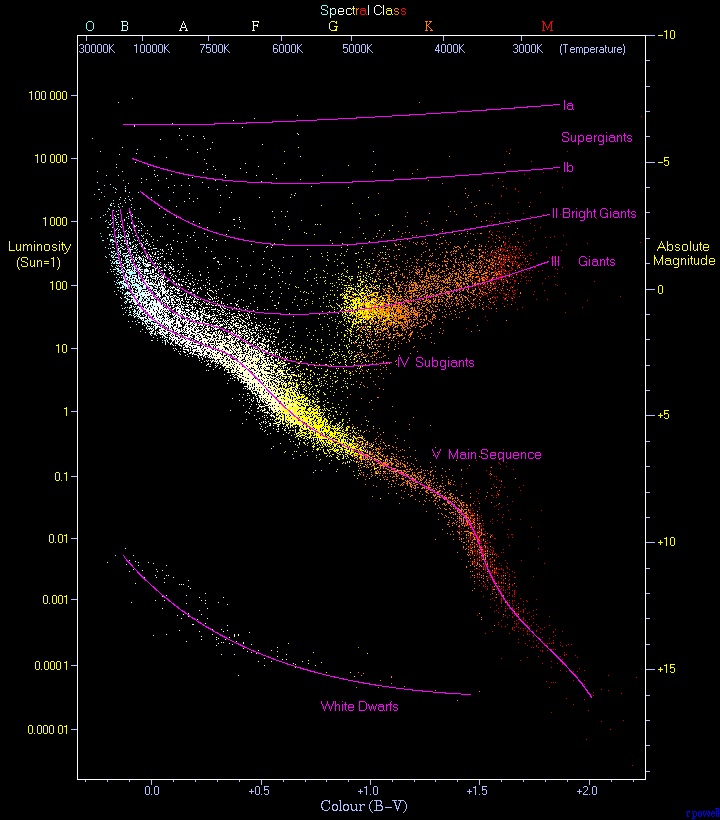
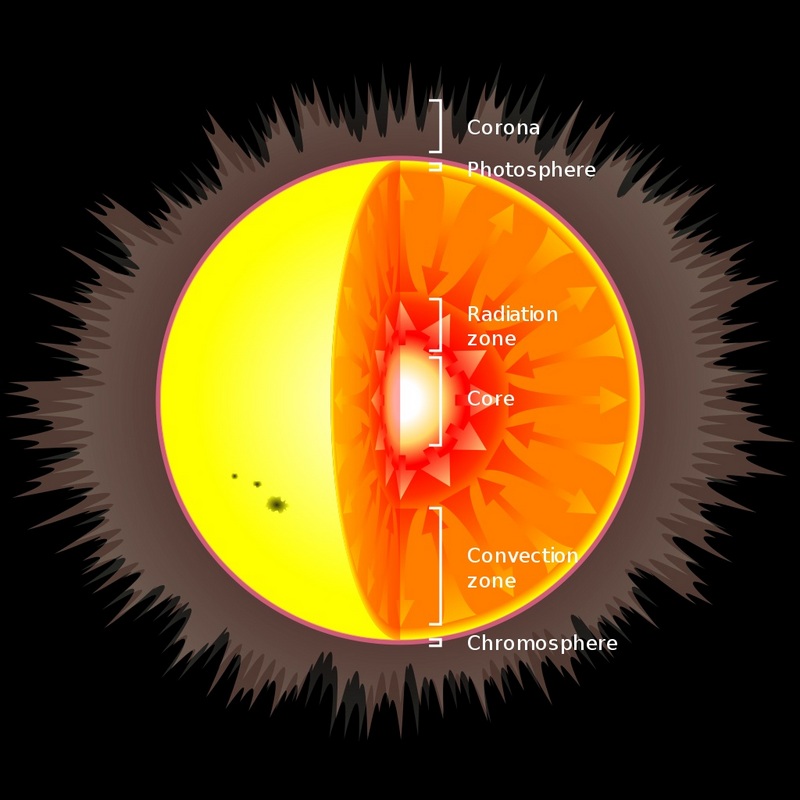
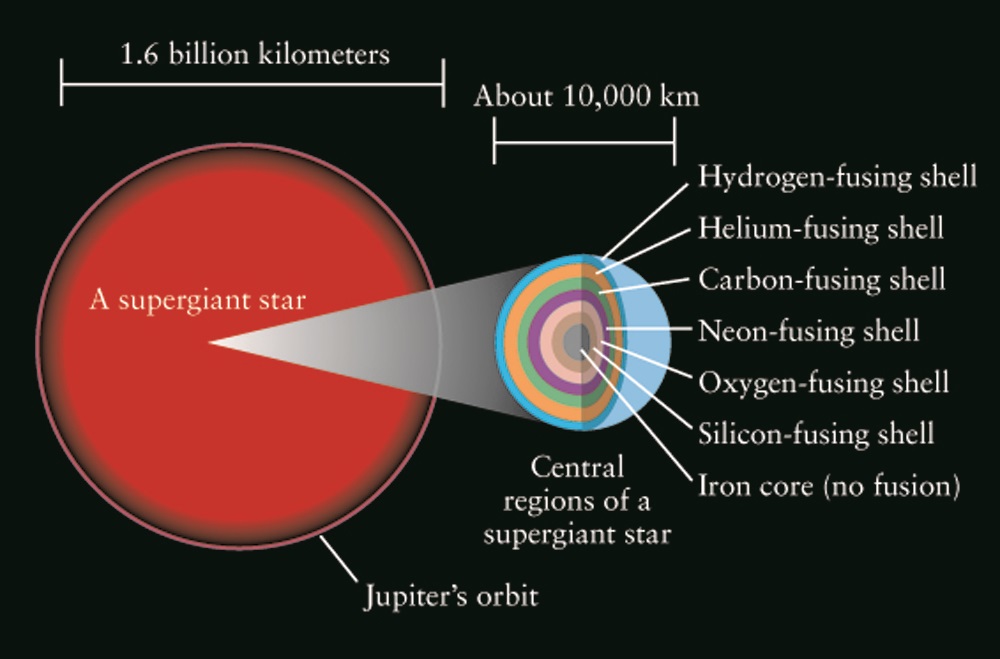

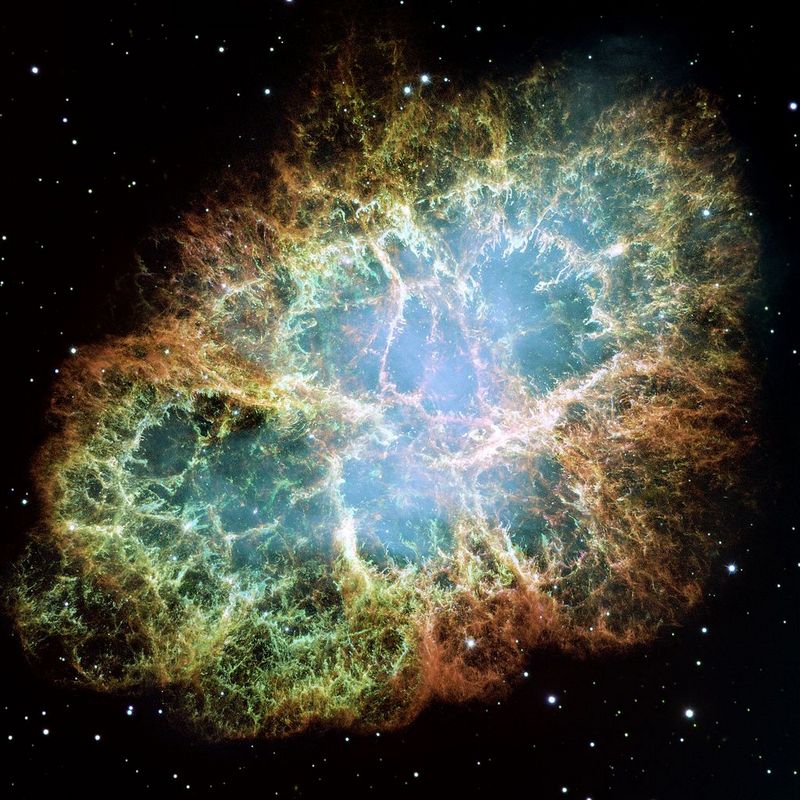
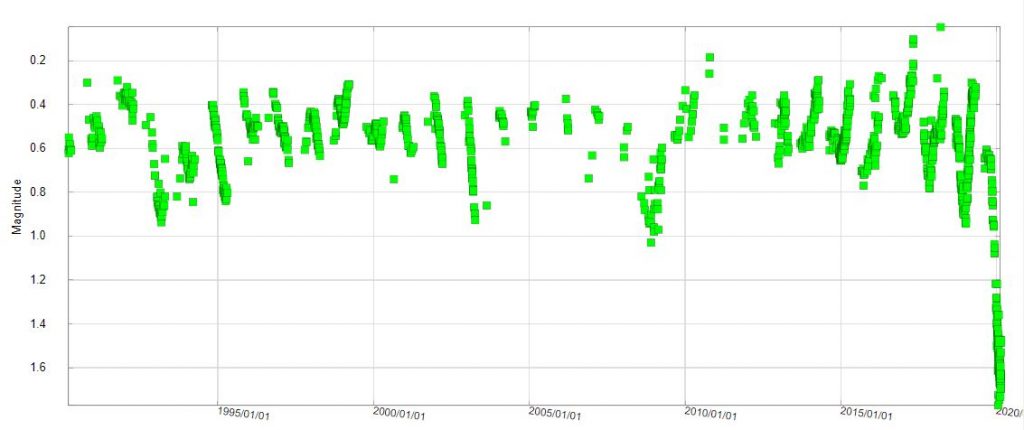
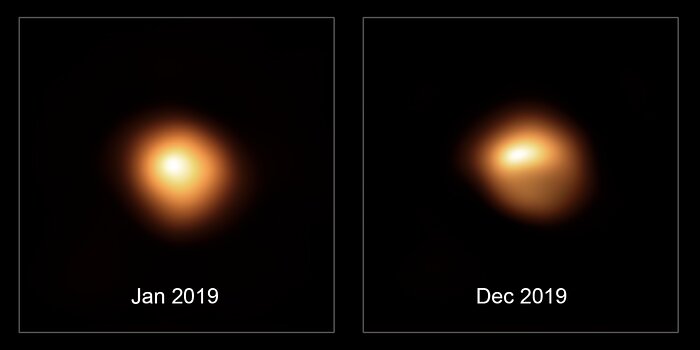
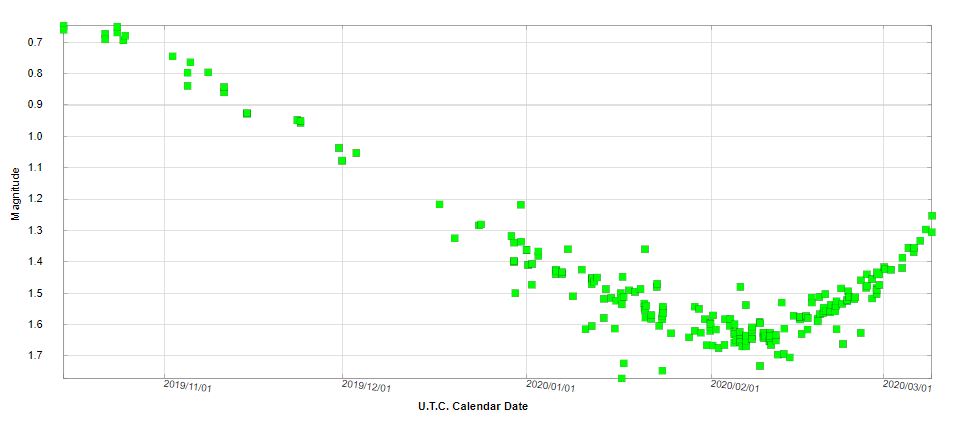
Thank you Jan, so very interesting these astronomy talks. I have always loved you telling us being star children.